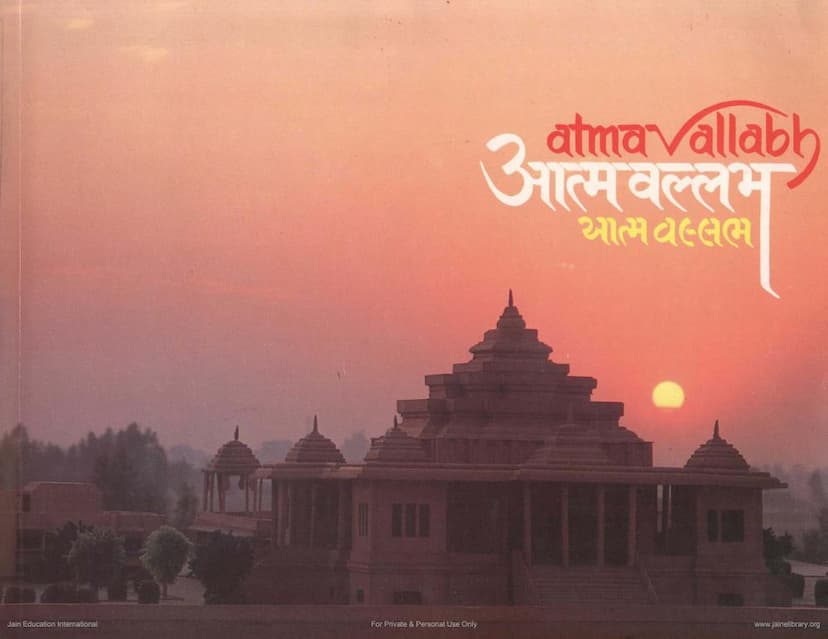Atmavallabh
Added to library: September 1, 2025

Summary
This summary is based on the provided text, which appears to be a souvenir booklet titled "Atmavallabh" published by Atmavallabh Sanskruti Mandir. The booklet commemorates the Vijay Vallabh Smarak Anjanshlaka Pratishtha Mahotsav and the Silver Jubilee of the All India Shwetambar Jain Conference in February 1989.
Overall Purpose:
The booklet serves as a commemorative souvenir for a significant Jain religious and cultural event. It highlights the life and contributions of prominent Jain Acharyas, particularly focusing on the legacy of Acharya Shri Vijay Vallabh Surishwarji Maharaj and the establishment of the Vijay Vallabh Smarak (Memorial) in Delhi. It also emphasizes the principles of Jainism, its history, art, architecture, and the importance of community service and spiritual development.
Key Figures and Their Contributions:
The text provides biographical sketches and tributes to several influential Jain Acharyas:
- Acharya Shri Vijayanand Surishwarji Maharaj (also known as Shri Atmaram Ji Maharaj): Born in Punjab, he was a highly learned and influential Acharya who played a crucial role in reviving and propagating Jainism. He is credited with a vast amount of literary work, including poems, hymns, and prayers, and the establishment of numerous educational institutions like schools, colleges, and libraries. He was also a proponent of social reforms, including advocating for women's education and the upliftment of the middle class. He had a broad vision for Jainism, aiming for unity among different sects and the establishment of a Jain University. He also supported the Swadeshi movement and Khadi.
- Acharya Shri Vijay Vallabh Surishwarji Maharaj: The most prominently featured figure, he was the disciple and successor of Acharya Vijayanand Surishwarji. His life is presented as a testament to dedication, renunciation, and selfless service. He is described as a visionary who recognized the need for education and established numerous educational institutions across India, including the Mahavir Jain Vidyalaya in Bombay and Atmanand Jain College in Ambala. He was a strong advocate for practical education alongside religious teachings and emphasized moral values, compassion, and humanity. His influence extended beyond the Jain community, attracting followers from other religions due to his universal message of peace and brotherhood. He is also highlighted as a prolific poet and scholar.
- Acharya Shri Vijay Samudra Surishwarji Maharaj: Known for his effective preaching and profound knowledge, he was born in Rajasthan. He was initiated into Jainism by Acharya Vijay Vallabh Surishwarji Maharaj and followed his guru's teachings diligently. He was a strong advocate for humanity and national integration, urging people to donate for national defense during the India-China war. He was honored with the title "Virushasanaram" for his service to the Jain administration.
- Acharya Shri Vijay Indradinna Surishwarji Maharaj: The current Gacchaadhipati (leader of the sect) at the time of the booklet's publication. He is described as a great spiritual leader who continued the legacy of his predecessors, spreading the message of Jainism and supporting numerous religious and social causes. His inspirational guidance was instrumental in the construction of the Vallabh Smarak. He is credited with converting many non-Jains to Jainism through his powerful discourses and his emphasis on universality and tolerance.
- Sadhavi Mrigavati Shri Ji Maharaj: A highly respected and influential Sadhvi who was instrumental in the realization of the Vallabh Smarak project. Her dedication, hard work, and unwavering commitment, even in the face of adversities and ill health, were crucial for the memorial's construction. She is portrayed as a spiritual guide, a social reformer, and a pillar of strength for the Jain community.
- Other figures mentioned: Several other revered Acharyas and scholars like Muni Vinod Vijay, Muni Punyavijay, Muni Vichakshan Vijay, Prof. Rooplal Verma, Prof. Ram Jain, Prof. R. L. Shah, Dr. Kumar Pal Desai, Prof. Panna Lal Nahata, and others contributed articles and eulogies to the booklet.
Key Themes and Concepts:
- Education: The importance of education for social upliftment and the establishment of numerous schools, colleges, and libraries are frequently emphasized, reflecting Acharya Vijay Vallabh's vision of "Saraswati Mandirs."
- Service and Sacrifice: The lives of these Acharyas are presented as examples of selfless service, renunciation, and dedication to the welfare of humanity and the Jain community.
- Unity and Harmony: There's a strong emphasis on promoting unity among different Jain sects (Gacchas) and fostering inter-religious harmony. Acharya Vijay Vallabh's efforts to bridge differences are highlighted.
- Ahimsa and Vegetarianism: The core principles of Jainism, particularly non-violence and vegetarianism, are consistently promoted as fundamental to a righteous life.
- Spiritual Development: The ultimate goal of liberation (Moksha) through self-discipline, knowledge, and virtuous conduct is a recurring theme.
- Community Building: The establishment of institutions like the Vallabh Smarak, educational centers, and charitable foundations are presented as vital for the progress and preservation of Jainism.
- Legacy of Acharyas: The booklet serves as a tribute to the enduring legacy of these spiritual leaders, whose teachings and actions continue to inspire generations.
- Art and Architecture: The booklet includes sections on Jain temples and sculptures, showcasing the rich artistic and architectural heritage of Jainism, particularly highlighting the Vallabh Smarak itself as a masterpiece.
- Moral Values: Emphasis is placed on virtues like simplicity, humility, compassion, forgiveness, and adherence to moral principles.
The Vallabh Smarak:
The Vijay Vallabh Smarak in Delhi is presented as a significant achievement, a physical embodiment of Acharya Vijay Vallabh Surishwarji's ideals. Its construction is described as a massive undertaking, supported by the collective efforts and donations of the Jain community. The Smarak is envisioned not just as a memorial but as a center for learning, research, and cultural activities, continuing the legacy of its namesake.
Overall Tone:
The booklet is written with immense reverence and admiration for the featured Acharyas. It aims to educate, inspire, and foster a sense of pride and devotion among the Jain community, while also presenting the rich heritage and philosophical depth of Jainism to a wider audience.